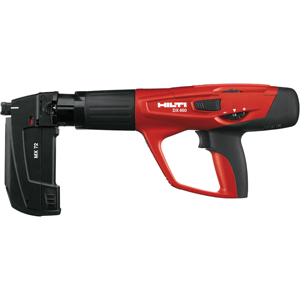The power of a powder-actuated tool comes from an explosive charge. The tool drives a fastener into materials such as masonry, concrete, steel, and other hard surfaces using the expanding gas from the explosion. A powder-actuated tool can only be used by trained, competent, and authorized individuals. It is important that the training be in accordance with the tool manufacturer’s requirements. Following training, the authorized person should receive a card verifying training. A powder-actuated tool can cause serious injury or death if improperly used or unauthorized.
You should test the powder actuated tool each day before loading, even if you have been trained and authorized to use it. A shield should be placed perpendicular to the barrel at the muzzle end of the tool to prevent fragments from flying. Remove the tool from service if you find that it is damaged or defective.
Since powder-actuated tools function like loaded guns, they should be handled with the same respect and safety precautions. You should always select the correct powder-actuated tool for the fastener being used, then load the tool just before using it, keeping your hands clear of the open barrel end. Don’t leave a loaded powder-actuated tool unattended. When using a tool, always point it in a safe direction. Do not point it at anyone.
Be sure to wear appropriate personal protection equipment when using a powder-actuated tool, such as safety glasses or a face shield and hearing protection. Powder-actuated tools must be held firmly against and perpendicular to the surface into which they are driving fasteners. Maintain good balance when using powder-actuated tools on ladders or scaffolds. Never shoot into a blind surface unless you’re certain the fastener will be contained safely.
Ensure that no one is in the way of the fastener on the other side of the surface. Stay at least 3 inches away from edges or corners when driving fasteners into materials such as brick or concrete. If the fastener is made of steel, it must stay at least half an inch away from a corner or edge. Do not allow anyone to be close to the work area. Workers may need protection against ricochets in a working area.
Fasteners should not be driven into very hard or brittle materials such as cast iron, glass blocks, glazed tiles, or other materials that could shatter, ricochet off, or pass through. Make sure you don’t drive fasteners into spalled areas or into holes where a previous fastening failed. You should avoid using powder-actuated tools in flammable, combustible, or explosive environments. When a powder-actuated tool misfires, wait at least 30 seconds before firing it again. If it still doesn’t fire, wait another 30 seconds to reduce the chances of the cartridge going off. After that, remove the cartridge and place it in water.







